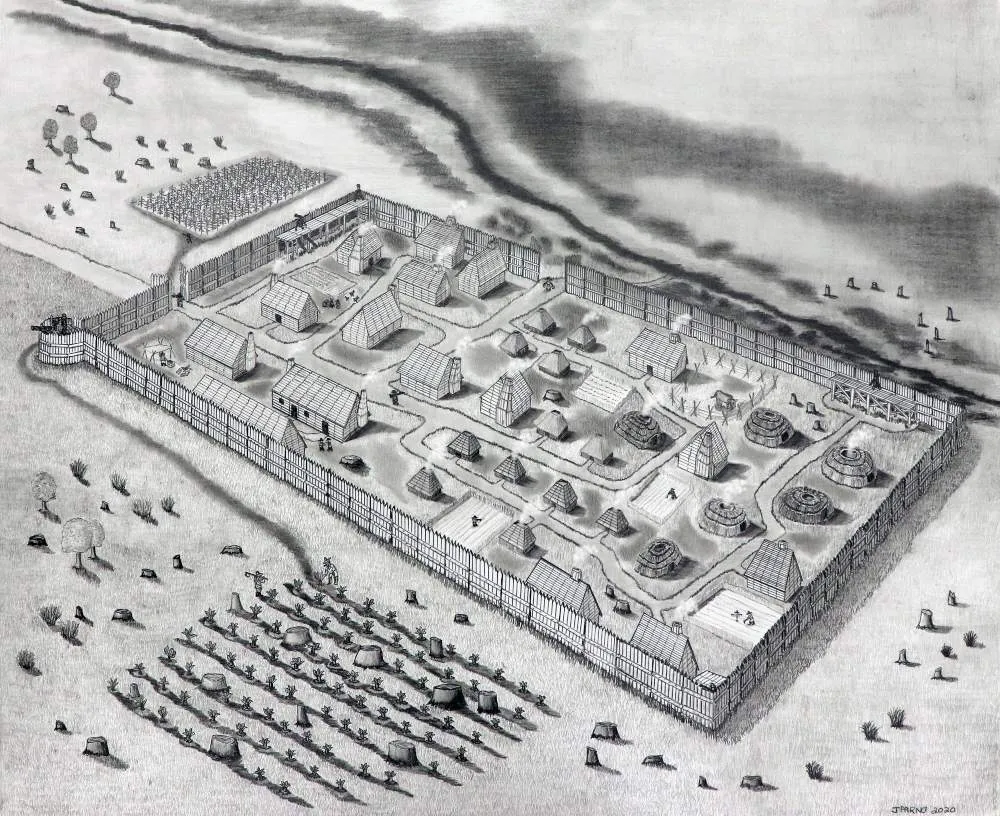Rare 17th-Century Coin Featuring Charles I’s Likeness Found in Maryland
Archaeologists found a telltale silver shilling at the likely site of St. Mary’s Fort, a 1634 structure built by early English colonists
:focal(912x506:913x507)/https://tf-cmsv2-smithsonianmag-media.s3.amazonaws.com/filer/b0/f6/b0f63e80-cb96-40f6-aa7b-97f60aee7dd7/screen_shot_2021-05-18_at_22821_pm.png)
In late 2019, archaeologists unearthed the remains of a key landmark in American history: St. Mary’s Fort. A football field–sized plot of land in southern Maryland, the defensive outpost—established by English colonists in 1634—housed the first permanent European settlement in the state and the fourth such settlement in British North America.
Historic St. Mary’s City publicly announced the discovery in March 2021 to much fanfare. In the months since, researchers led by Travis Parno have carefully examined additional evidence found at the site in hopes of further solidifying their claims about the fort’s historic roots.
Now, Parno and his colleagues have once again struck gold—or, more accurately, silver. In late April, archaeologists announced that they’d found a rare silver coin at the fort. The shilling bears inscriptions indicating that it was minted in London between 1633 and 1634, reports Colleen Grablick for DCist.
As Michael E. Ruane writes for the Washington Post, the coin’s discovery allows researchers to confidently date the dig site to 1634, the year that English settlers first arrived in Maryland.

“It’s a key dating tool that suggests this is a very early 17th-century site,” Parno tells Live Science’s Tom Metcalfe. “We’ve got a lot of artifacts that are really pointing us to an early 17th-century date, so finding a coin that nails that down to a very early period is really helpful.”
The team also discovered a “tinkling cone,” or small piece of copper with a leather cord used in trade between Indigenous people and colonists, and a five saints medallion. The religious object is a remnant of early Jesuit missionary efforts in the Maryland colony. Together with the coin, notes DCist, these three “diagnostic artifacts” give the researchers a high degree of confidence that they have indeed discovered the correct location of St. Mary’s Fort.
When archaeologists first excavated the shilling in November, it felt like “Christmas,” Parno tells DCist. Per the Post, archaeologist crew chief Stephanie Stevens discovered the coin and immediately texted an image of her find to Parno with an elated note: “OMG!”
Earlier in the dig, Parno had joked with his team that “if you could find me a coin that has 1634 on it, that would be helpful,” according to a St. Mary’s Fort Instagram post.
His team discovered just that.
The coin bears a telltale “mint mark”: a tiny image of a castle portcullis, or a type of closing gate typical in medieval European castles. As Parno tells Live Science, residents of later colonial forts employed tobacco—a valuable cash crop—as currency, so the shilling’s presence site strongly suggests that it was the first European settlement in the region.
/https://tf-cmsv2-smithsonianmag-media.s3.amazonaws.com/filer/51/d2/51d2ca0a-9713-4954-adbd-7e6bd5615870/st_marys_fort.jpeg)
Speaking with the Post, Parno says the coin was likely carried by someone with significant disposable income. (A single shilling was enough to afford some pottery but not much beyond that.) It may have been dropped by one of the original 150 colonists who traveled overseas with Maryland’s first governor, Leonard Calvert.
The coin depicts English king Charles I with a goatee and lace collar, per the Post. The ill-fated royal was deposed and beheaded in 1649, during the English Civil Wars, which pitted supporters of the monarchy against Oliver Cromwell’s Parliamentarian forces.
Archaeological work at St. Mary’s paused for a few months during the Covid-19 pandemic but resumed last summer. Parno tells DCist that his team has also excavated remnants of a violent colonial past, including cannon balls and musket equipment.
“That shows the other side of colonialism, that this was about land expansion, this was about empire,” Parno says. “It wasn’t just an effort to come over and make nice with Native people.”
Two neighboring archaeological digs are also investigating sites inhabited by Native American people nearly 5,000 years ago. Per its website, the “People to People” project—a collaboration between St. Mary’s Historic Site and the local Piscataway tribe—will promote research and educational initiatives around the “long history of Native occupation in St. Mary’s City and the first moments of colonial encounters.”
/https://tf-cmsv2-smithsonianmag-media.s3.amazonaws.com/accounts/headshot/nora.png)
/https://tf-cmsv2-smithsonianmag-media.s3.amazonaws.com/accounts/headshot/nora.png)